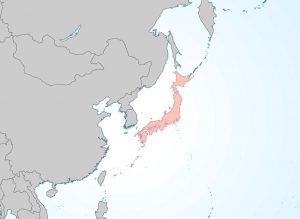59 East Asia: Population Geography I – Aging Japan
A High Median Age

The median age for a country is literally its middle age. For example, the median age in the United States is 38, meaning that about half the country’s population is 38 or older, and about half are 38 or younger. The global median age 31. Niger has the world’s lowest median age, a remarkably youthful 14. The world’s “oldest” country, with a median age of 48, is Japan. More than a quarter of Japan’s people are 65 or older. By the year 2036, they will make up more than a third of the population.
Why does Japan have a such a high median age? One simple answer is that the Japanese tend to live for a very long time. With an average life expectancy of 88 years, the Japanese live longer than the people of any other country on earth. By comparison, life expectancy in the United States is 79, while the global life expectancy is 74. In poorer regions, lifespans are considerably shorter, ranging as low as 54. Japan’s high incomes, low poverty rates, healthy eating habits, active lifestyles, and free universal health care are all common explanations for the country’s long lifespans.
Another reason for Japan’s high median age is its low birth rates. Not only are there an increasing number of old people, there are also a decreasing number of young people, both of which will cause the median age to skew higher. A country’s total fertility rate (TFR) reflects the average number of children a woman in that country will have in her lifetime. In order maintain population growth, a country generally must have a TFR over 2.1. Japan first dropped below that number in 1974, and its current TFR is 1.4, among the lowest on earth.
There are number of reasons for Japan’s low birth rates. To begin, it is a highly educated, highly urbanized, and wealthy society – all characteristics of a country deep into the demographic transition. Nearly every country on earth with those characteristics have populations that tend to get married later in life, if at all, and have fewer children, if at all. But Japan is one of the most extreme examples of this. Among Japanese citizens who are fifty years old or older, 24% of men and 14% of women have never been married. And those who do get married find children to be an enormous economic liability. Japan’s economic slowdown, which began in the 1990s, has made well-paying jobs harder to find. Additionally, those who do have good jobs often find themselves working long and stressful hours – a trademark of Japan’s business culture – reducing available time to care for children. Japan is also an extremely expensive place to live, with real estate being one of its most costly elements. Those who do decide to have children are unlikely to be able to afford more than one or two.
Consequences of an Aging Population
One obvious consequence of an aging population is eventual population decline. As mentioned above, the Japanese tend to live for a very long time, but everyone dies eventually, and if they are not replaced by newborns, population will decrease. This is already happening in Japan. The country’s population peaked in 2009 at 128 million. By 2022, Japan’s population had declined to 124 million – meaning that the country is experiencing a net loss of a million people every three years. If current demographic trends continue, Japan’s population will stand at 111 million in 2040, will fall below 100 million in 2053, and drop to 82 million by 2065.
The most immediate consequences of an aging population will be economic in nature. As a larger share of Japan’s population has entered their 70s and 80s, government health care expenditures have grown with them. Even with Japan’s remarkably healthy population, older people require more medical care than younger people. Health care expenditures in Japan recently exceeded 11% of the country’s gross domestic product.
There will be other significant economic hardships resulting from an aging population, with labor shortages being among the most significant. For every 100 people looking for work in Japan, there are 104 job openings. The problem is particularly acute in agriculture, and is likely to get much worse. In Japan, nearly two-thirds of the farm labor is currently over the age of 65. Consumption rates – the amount of money spent by Japanese consumers – are also falling. Older people tend to spend far less money than young people, partly because they have already purchased their homes, and things to fill those homes, but also because older people tend to be on fixed incomes. Japan’s meager pensions and low return on savings discourage the elderly from spending money. Finally, a hallmark of Japan’s economic miracle was technological and economic innovation, but many new innovations are driven by young people, of which Japan is increasingly deficient. In short, it is quite difficult to maintain economic growth with fewer workers, lower consumer spending, and less innovation.
Possible Solutions
There are really only two possible solutions to Japan’s age dilemma. The first is quite simple – Japan needs to produce more babies, and the government is trying to encourage people to have more children. In 2019, Japan made free preschool education available to all children ages 3 to 5, began providing monetary allowances to parents of children, and introduced paid parental leave for new parents that lasts an astounding 24 months. So far, it hasn’t worked. Parents still must find ways to provide daycare for their children once school hours are over, the monetary allowances have not apparently been significant enough, and even though parental leave is now available, Japan’s strenuous corporate culture has discouraged many workers from taking advantage of it.
The other solution is to encourage immigration. This is a strategy that many wealthy countries in late stages of the demographic transition have employed. But Japan has long been extremely averse to immigration. Only about 2% of its population is foreign-born, compared to 21% in Canada, 16% in Germany, and 15% in the United States. Traditionally, those who emigrated to Japan have been guest workers with no pathway to citizenship. They were expected to return home after five years, and were not allowed to bring their families along with them. In 2018, Japan enacted a policy that allowed a limited number highly skilled workers and their families to live in the country indefinitely, but Japanese firms have been hesitant to take advantage of this policy. In 2019, only 3% of the program’s quota was filled.
Did you know?
Hot Off the Press
In predictions for the highest percentage population declines for 2020-2050, Japan is the only of the top ten that isn’t a former or current communist country. https://www.visualcapitalist.com/ranked-the-20-countries-with-the-fastest-declining-populations/
The Financial Times, on 22 February 2023, reports that Japanese prime minister Fumio Kishida cites the Japanese economy as being on the brink of social dysfunction, due to the declining population. In the last five years, the average annual decline in births is 3.65%. Potential parents in Japan cite the cost of raising a child as their top deterrent to having a child.
Cited and additional bibliography:
Iwamoto, Kentaro. “Japan Readies ‘Last Hope’ Measures to Stop Falling Births.” Financial Times, https://www.ft.com/content/166ce9b9-de1f-4883-8081-8ec8e4b55dfb. February 22, 2023.
Suzuki, Emi, and Haruna Kashiwase. The Curse of the Fire-Horse: How Superstition Impacted Fertility Rates in Japan. World Bank Blogs. 22 Jan. 2019, https://blogs.worldbank.org/opendata/curse-fire-horse-how-superstition-impacted-fertility-rates-japan.


